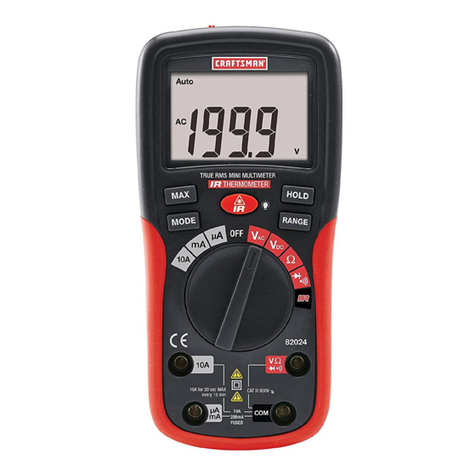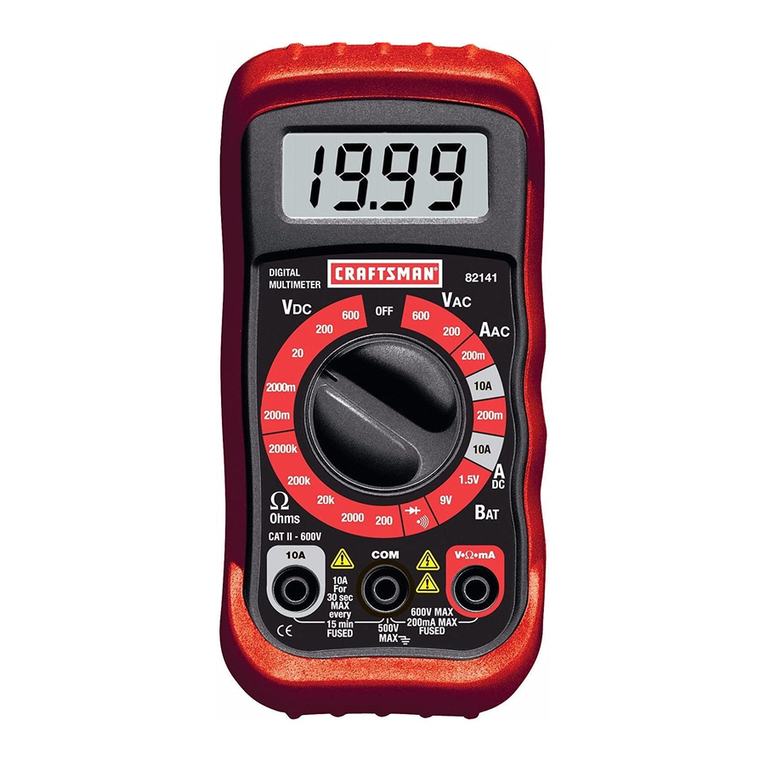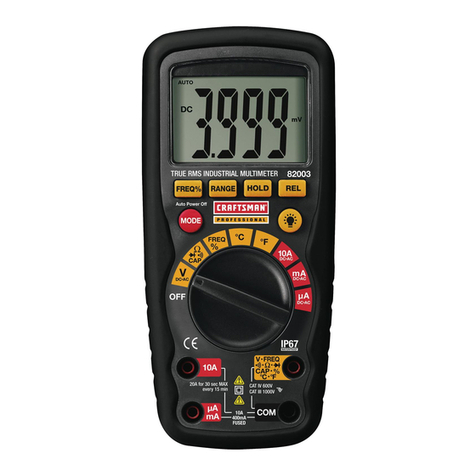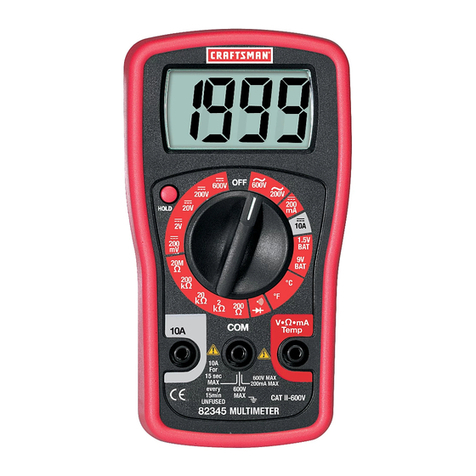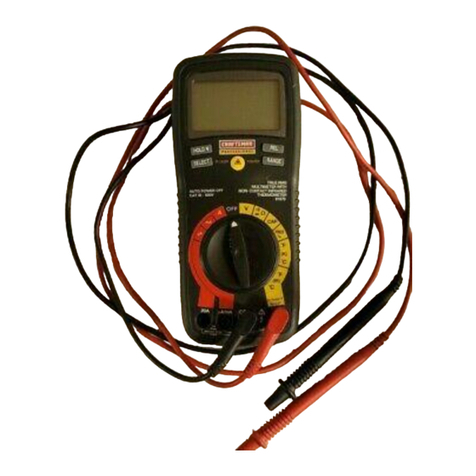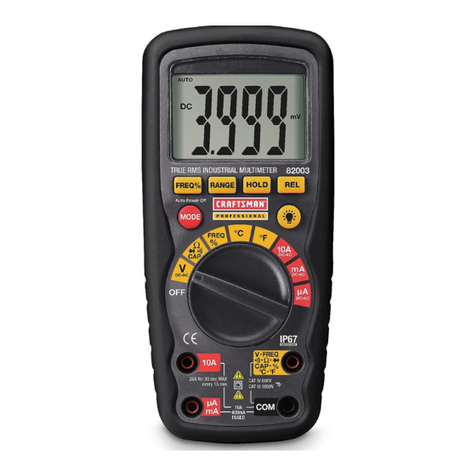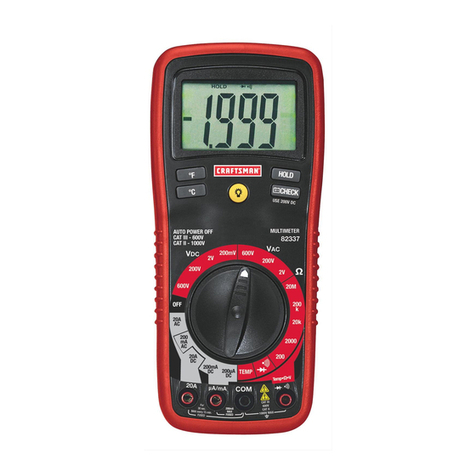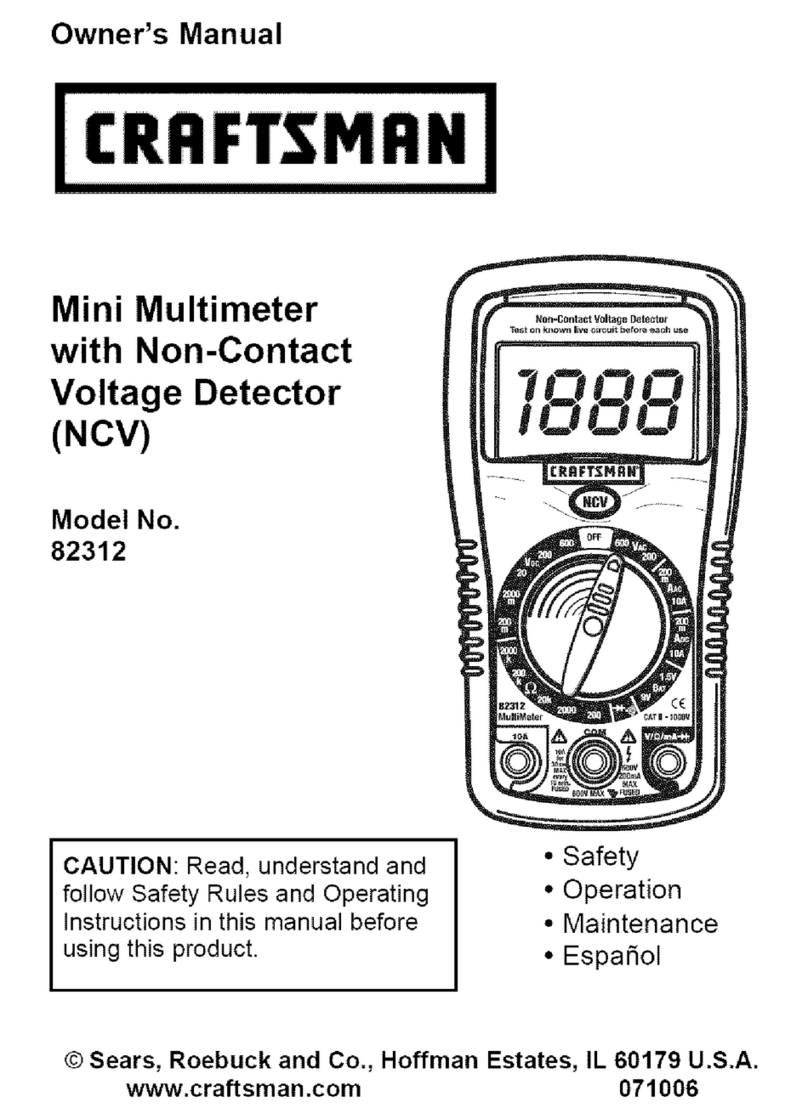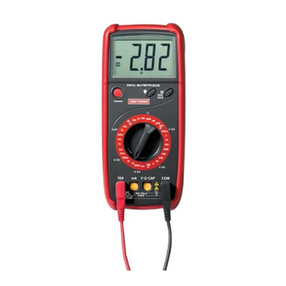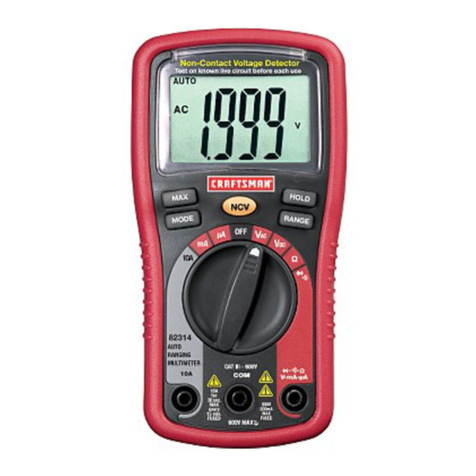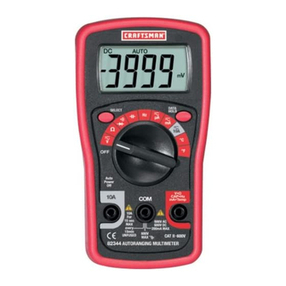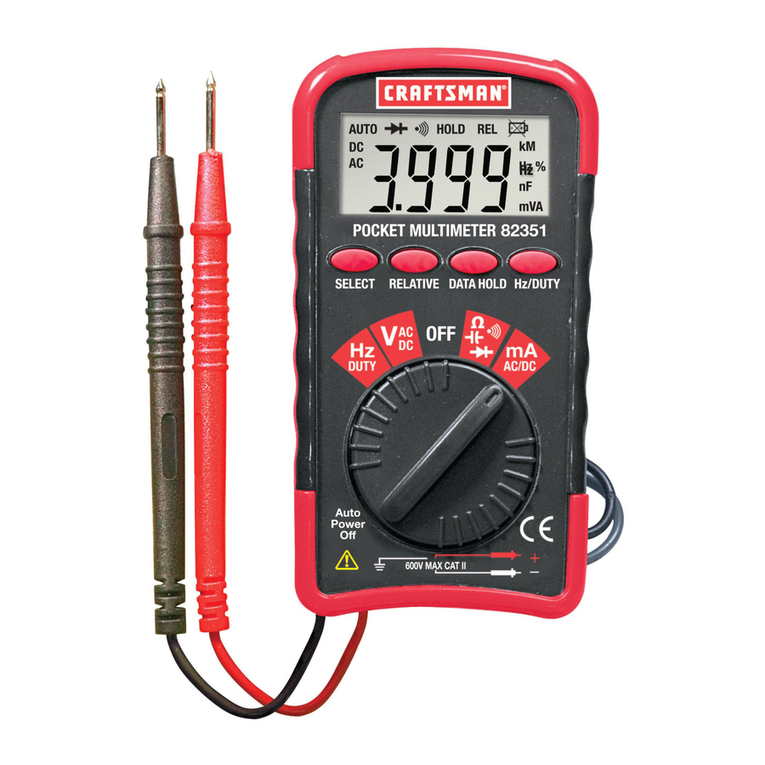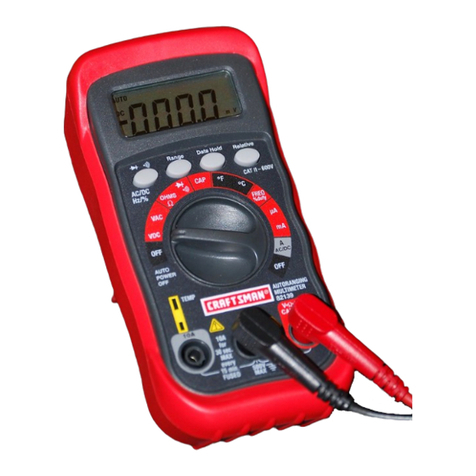BATTERY INSTALLATION
WARNING: To avoid electric shock, disconnect the test leads from any
source of voltage before removing the battery cover.
1. Remove the rubber holster (if in place)
2. Remove Philips head screw and lift off the rear housing of the meter.
3. Replace old battery with fresh CR2032 type button battery.
4. Replace the rear cover and secure the screw.
OPERATING INSTRUCTIONS
WARNING: Risk of electrocution. High-voltage circuits, both AC and DC, are
very dangerous and should be measured with great care.
1. ALWAYS turn the function switch to the OFF position when the meter is not
in use.
2. Press the HOLD button to freeze a displayed reading
NOTE: On some low AC and DC voltage ranges, with the test leads not
connected to a device, the display may show a random, changing reading.
This is normal and is caused by the high-input sensitivity. The reading will
stabilize and give a proper measurement when connected to a circuit.
AC OR DC VOLTAGE MEASUREMENT
WARNING: Risk of Electrocution. The probe tips may not be long enough
to contact the live parts inside some 240V outlets for appliances because
the contacts are recessed deep in the outlets. As a result, the reading may
show 0 volts when the outlet actually has voltage on it. Make sure the probe
tips are touching the metal contacts inside the outlet before assuming that
no voltage is present.
CAUTION: Do not measure AC voltages if a motor on the circuit is
being switched ON or OFF. Large voltage surges may occur that can
damage the meter.
CAUTION: Do not measure DC voltages if a motor on the circuit is
being switched ON or OFF. Large voltage surges may occur that can
damage the meter.
1. Set the function switch to the “VAC/DC” position
2. Press the SELECT button to select AC or DC voltage measurement
3. Touch the test probe tips to the circuit under test. Be sure to observe the
correct polarity (red lead to positive, black lead to negative).
4. Read the voltage on the display
RESISTANCE/CONTINUITY MEASUREMENT
WARNING: To avoid electric shock, disconnect power to the unit under
test and discharge all capacitors before taking any resistance
measurements. Remove the batteries and unplug the line cords.
1. Set the function switch to the “ •))) ” position.
2. Connect the test leads to the circuit to be measured.
3. Read the value on the display.
4. For Continuity tests, press the SELECT button until the “•)))“ symbol
appears in the display.
5. If the resistance is less than 60 ohms, an audible tone will sound.
CAPACITANCE MEASUREMENT
WARNING: To avoid electric shock, disconnect power to the unit under
test and discharge all capacitors before taking any capacitance
measurements. Remove the batteries and unplug the line cords.
1. Set the function switch to the “ •))) ” position.
2. Press the SELECT button until “nF” appears in the display.
3. Press the RELATIVE button to zero the display
4. Connect the test leads to the capacitor to be measured.
5. Read the value on the display.
DIODE TEST
WARNING: To avoid electric shock, do not test any diode that has
voltage on it.
1. Set the function switch to “ •))) “position.
2. Press the SELECT button once to enter Diode Test. The “ “ symbol will
appear in the display.
3. Touch the test probe tips to the diode or semiconductor junction you wish to
test. Note the meter reading.
4. Touch the test probes to the diode under test. Forward voltage will
typically indicate 0.400 to 0.700V. Reverse voltage will indicate
“OL”. Shorted devices will indicate near 0V and an open device will
indicate “OL” in both polarities.
AC OR DC CURRENT MEASUREMENT
1. Set the function switch to the “mA AC/DC” position.
2. Press the SELECT button to measure AC or DC mA.
3. Remove power from the circuit under test and open the circuit at the point
where you wish to measure current.
4. Touch the black test probe tip to the negative side of the circuit and touch
the red test probe tip to the positive side of the circuit.
5. Apply power to the circuit.
6. Read the value on the display
FREQUENCY/DUTY CYCLE MEASUREMENT
1. Set the function switch to the “HZ/DUTY” position.
2. Press the Hz/DUTY button once to display Duty Cycle %. Pressing the
button again will toggle the display to frequency (Hz).
3. Touch the test probe tips to the circuit under test. Be sure to observe the
correct polarity (red lead to positive, black lead to negative).
4. Read the value on the display.
RELATIVE BUTTON
The relative measurement feature allows you to make measurements relative
to a stored reference value. A reference voltage can be stored and
measurements made in comparison to that value. The displayed value is the
difference between the reference value and the measured value.
1. Perform the measurement as described in the operating instructions.
2. Press the RELATIVE button to store the reading in the display and the "REL"
indicator will appear on the display.
3. The display will now indicate the difference between the stored value and
the measured value.
4. Press the RELATIVE button to exit the relative mode.
Note: The Relative function does not operate in the Frequency function.
DATA HOLD BUTTON
The Data Hold function allows the meter to “freeze” a measurement for later
reference
1. Press the “DATA HOLD” button to “freeze” the display, the “HOLD” indicator
will appear.
2. Press the “DATA HOLD” button to return to normal operation.
AUTO POWER OFF
1. To save power, the display automatically turns off in 30 minutes.
2. Press the SELECT button to turn display back on.
3. To cancel Auto Power Off, set the function switch to the off position. Hold
down the SELECT button and turn the function switch to the desired position
and release the SELECT button after 3 seconds.
MAINTENANCE
WARNING: To avoid electric shock, disconnect the test leads from any
source of voltage before removing the back cover or the battery or fuse
covers.
WARNING: To avoid electric shock, do not operate your meter until the
battery and fuse covers are in place and fastened securely.
This MultiMeter is designed to provide years of dependable service, if the
following care instructions are performed:
1. KEEP THE METER DRY. If it gets wet, dry it immediately.
2. USE AND STORE THE METER IN NORMAL TEMPERATURES.
Temperature extremes can shorten the life of the electronic parts and
distort or melt plastic parts.
3. HANDLE THE METER GENTLY AND CAREFULLY. Dropping it can
damage the electronic parts or the case.
4. KEEP THE METER CLEAN. Wipe the case occasionally with a damp
cloth. DO NOT use chemicals, cleaning solvents, or detergents.
5. USE ONLY FRESH BATTERIES OF THE RECOMMENDED SIZE AND
TYPE. Remove old or weak batteries so they do not leak and damage the
unit.
6. IF THE METER IS TO BE STORED FOR A LONG PERIOD OF TIME,
the batteries should be removed to prevent damage to the unit.
UL LISTED
The UL mark does not indicate that this product has been evaluated for the
accuracy of its readings.
TROUBLESHOOTING
There may be times when your meter does not operate properly. Here are
some common problems that you may have and some easy solutions to them.
Meter Does Not Operate:
1. Always read all the instructions in this manual before use.
2. Check to be sure the battery is properly installed.
3. Check to be sure the battery is good.
4. If the battery is good and the meter still doesn’t operate, check to be sure
that both ends of the fuse are properly installed.
If You Do Not Understand How the Meter Works:
1. Purchase “Multitesters and Their Use for Electrical Testing”,
(Item No. 82303).
2. Call our Customer Service Line 1-888-326-1006.
